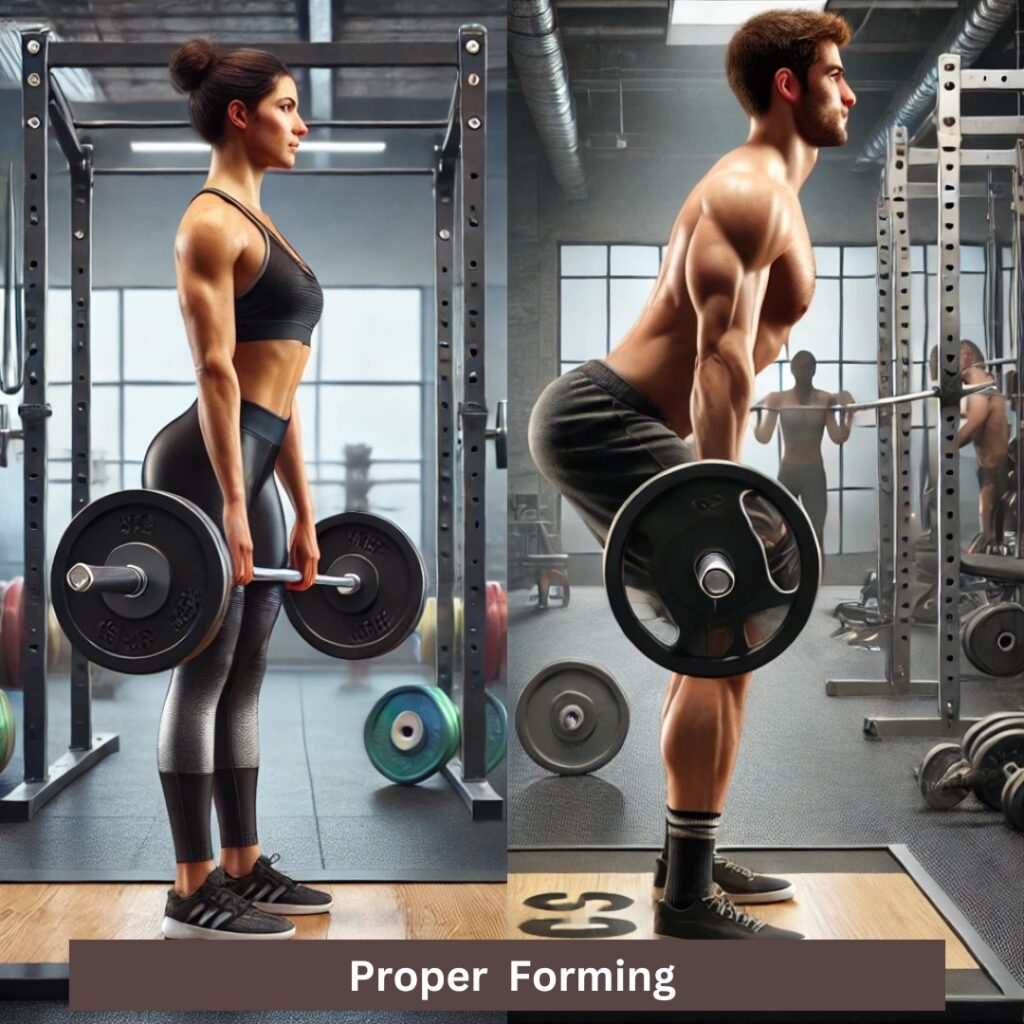Disclosure:
Thank you for reading this post, don't forget to subscribe!
Some of the links on this website are affiliate links. This means that if you click on the link and make a purchase, we may receive a small commission at no extra cost to you. Your support helps us keep the site running.Learn more on my Privacy Policy and Affiliate Disclosure page. Thank you for your support!

Strength training has become an essential part of fitness routines for people of all ages and fitness levels. Whether you’re lifting heavy in the gym or performing bodyweight exercises at home, mastering proper form is crucial. Not only does correct technique enhance your performance and help you reach your goals faster, but it also protects you from injury. In this article, we’ll explore the importance of proper form in strength training and how it can significantly impact your long-term fitness success.
What is Proper Form in Strength Training?
Proper form refers to the correct alignment and movement of your body during exercise. This means ensuring that each part of your body is moving in the correct position throughout the entire range of motion. Whether you’re squatting, deadlifting, or pressing, maintaining proper posture and technique ensures that you engage the right muscles while minimizing strain on joints and ligaments.
Why Does Proper Form Matter?
Proper form is essential for several reasons:
- Prevents Injuries: Poor form often leads to muscle strains, joint injuries, and even long-term damage. For example, a rounded back during deadlifts can strain your lower back, while improper knee alignment in squats can lead to knee injuries.
- Maximizes Muscle Engagement: Correct form helps activate the intended muscles. When you focus on technique, you recruit the target muscles more efficiently, resulting in better strength and muscle gains.
- Improves Performance Over Time: Proper form enhances overall movement mechanics. This can improve not just your strength training but also daily movements and athletic performance.
Pro Tip: Always begin with a lighter weight when learning new exercises to perfect your form before increasing the load. You can gradually increase weight once you’re confident that your form is correct.
learn more about: 5 Most Common Gym Mistakes and How to Avoid Them-Exercisers with the best intentions may undermine their progress by going to the gym without a plan or ignoring nutritional guidelines.
The Dangers of Poor Form in Strength Training
The consequences of poor form in strength training can be severe. Not only does it hinder your progress, but it can also cause immediate and long-term health issues.
Risk of Injury
One of the most critical risks of improper form is injury. According to studies, up to 40% of gym injuries are related to incorrect lifting technique. Common injuries caused by bad form include:
- Muscle Strains: Overworking the wrong muscles due to improper movement.
- Joint Damage: Misaligned joints can lead to sprains, dislocations, or wear and tear over time.
- Lower Back Pain: Incorrect form, especially in exercises like deadlifts or bent-over rows, can put excessive strain on the spine, causing lower back pain.
Stagnated Progress
When you fail to use the correct form, your body isn’t efficiently using the targeted muscles. This can cause muscle imbalances and prevent you from reaching your fitness goals. Over time, you may hit a plateau because improper form limits muscle growth and strength gains.
Did You Know? Many lifters struggle to see results not because they aren’t working hard but because they aren’t using proper technique, which reduces muscle activation.
Common Form Mistakes and How to Fix Them

Let’s dive into some common form mistakes for popular exercises and how you can correct them to avoid injury and improve your performance.
1. Squats
- Common Mistake: Letting the knees collapse inward or rounding the lower back.
- Fix: Keep your knees aligned over your toes and maintain a neutral spine. Imagine sitting back into a chair to avoid excessive knee strain.
2. Deadlifts
- Common Mistake: Rounding the back, which places unnecessary stress on the lower spine.
- Fix: Keep your chest up, shoulders back, and core engaged. The barbell should remain close to your shins as you lift.
3. Bench Press
- Common Mistake: Flaring the elbows too wide, which can stress the shoulders.
- Fix: Keep your elbows at a 45-degree angle from your body and retract your shoulder blades to protect your shoulders.
Pro Tip: Record yourself while performing these exercises to identify form issues. This will help you self-correct and make real-time adjustments.
discover: Complete Guide to Mastering the Deadlift-The deadlift is one of the purest forms of strength training.
How to Develop and Maintain Proper Form
Learning proper form is a process that requires attention, practice, and sometimes external guidance. Here’s how you can develop the right technique:
1. Start Light
Always start with a weight that you can comfortably handle while maintaining proper form. Gradually increase the load as your technique improves. Trying to lift too much too soon is one of the fastest ways to develop poor form and risk injury.
2. Use Mirrors or Record Videos
Mirrors can be incredibly helpful in providing real-time feedback on your form. Alternatively, recording your workout can allow you to review and identify any mistakes after the session.
3. Work with a Trainer
If you’re unsure about your form, working with a certified personal trainer can make a world of difference. A professional can spot imbalances and give you tailored advice on how to improve.
Mind-Muscle Connection: A Key to Proper Form
While many people focus on the physical aspect of strength training, there’s also a mental side to it. Developing a mind-muscle connection—the ability to focus your attention on the muscle you’re working—can drastically improve your form.
How Does It Work?
By mentally focusing on the muscle you are targeting, you enhance muscle activation, which improves technique and effectiveness. For example, during bicep curls, think about squeezing your biceps with every rep. This helps improve both muscle growth and overall control of the movement.
Spiritual Note: Developing body awareness through proper form can be a meditative practice. Connecting with your body’s movements can foster mindfulness, reduce stress, and improve overall mental well-being, making strength training a holistic experience.
EXPLORE MORE:
- Digital Detox for Your Health: Why Less Screen Time Improves Sleep, Stress, and Energy
- Healthy Aging Secrets: Habits That Keep Your Body Strong and Mind Sharp
- 15-Minute Workouts: How to Get Fit When You Don’t Have Time
- Protein Made Simple: Everyday Sources Beyond Chicken and Shakes
- 5-Minute Morning Habits That Can Shift Your Entire Day
read more about: How Mind-Muscle Connection Can Improve Your Workouts– This article explores the importance of balancing chest and back workouts and provides tailored workout routines for both men.
Strength Training for Longevity: How Proper Form Plays a Role
Proper form isn’t just about short-term gains; it plays a crucial role in long-term fitness and health. As you age, maintaining correct technique will help preserve joint health, prevent injuries, and improve your mobility.
Strength training, when done with proper form, can also prevent chronic issues such as poor posture, back pain, and joint degeneration. It’s an investment in your health that pays off both in the short and long term.
Further Reading: Full-Body Strength Training: A Beginner’s Guide to Building a Stronger, Healthier You-Full-body strength training helps you build muscle strength and endurance by engaging various muscle groups in a single session.
Conclusion: Prioritize Proper Form for Lasting Results
Strength training can transform your body, boost your strength, and improve your overall health. But to fully reap the benefits, you must prioritize proper form. Not only will you prevent injuries, but you’ll also accelerate your progress and set yourself up for long-term success.
So next time you hit the gym, focus on your technique, consider working with a trainer, and remember: proper form is the foundation of strength training excellence.
mORE ABOUT:
HEALTH / WELLNESS / FITNESS / NUTRITION
Share this article







